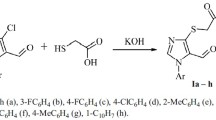Abstract
The induction of lipid peroxidation in hepatic microsomes of rodents treated with 2,3,7,8-tetrachlorodibenzo-p-dioxin (TCDD) is well documented. The potential mechanisms involved in TCDD-induced microsomal lipid peroxidation were investigated, using selected inhibitors and free radical scavengersin vitro. Rats were treated with 40 μg TCDD/kg orally as a single dose. Inhibitors of phospholipase A2, including a variety of phenothiazines, dibucaine, imipramine, and verapamil, inhibitedin vitro microsomal lipid peroxidation in response to TCDD administration. In addition, the lipoxygenase inhibitor quercetin, and the hydrogen peroxide scavenger aminopyrine inhibited lipid peroxidation with microsomes from TCDD-treated rats. The singlet oxygen scavenger β-carotene, the cytochrome P-450 substrate benzphetamine, and the cyclooxygenase inhibitor indomethacin produced moderate enhancement of hepatic microsomal lipid peroxidation. The results suggest that activation of phospholipase A2 may play a critical role in the metabolic events associated with hepatotoxicity and ultimate cell death produced by TCDD. The results also support the involvement of hydrogen peroxide in TCDD-induced microsomal lipid peroxidation.
Similar content being viewed by others
References
Agarwal AK, Mehendale HM (1984) CCl4-induced alterations in Ca2+ homeostasis in chlordecone and phenobarbital pretreated animals. Life Sci 34:141–148
Al-Bayati ZAF, Stohs SJ (1987) The role of iron in 2,3,7,8-tetrachlorodibenzo-p-dioxin (TCDD)-induced lipid peroxidation in rat liver microsomes. Toxicol Lett 38:115–121
Al-Bayati ZAF, Murray WJ, Pankaskie MC, Stohs SJ (1988a) 2,3,7,8-Tetrachlorodibenzo-p-dioxin (TCDD) induced perturbation of calcium distribution in the rat. Res Commun Chem Pathol Pharmacol 60:47–56
Al-Bayati ZAF, Wahba ZZ, Stohs SJ (1988b) 2,3,7,8-Tetrachlorodibenzo-p-dioxin (TCDD)-induced alterations in lipid peroxidation, enzymes, and divalent cations in rat testis. Xenobiotica 18:1281–1289
Beckman JK, Borowitz SM, Burr I (1987) The role of phospholipase A activity in rat liver microsomal lipid peroxidation. J Biol Chem 262:1479–1481
Bellomo G, Thor H, Orrenius S (1984) Increase in cytosolic Ca2+ concentration during t-butyl hydroperoxide metabolism by isolated hepatocytes involves NADPH oxidation and mobilization of intracellular Ca2+ stores. FEBS 168:38–42
Bombick DW, Madhukar BV, Brewster DW, Matsumura F (1985) TCDD (2,3,7,8-tetrachlorodibenzo-p-dioxin) causes increase in protein kinases particularly protein kinase C in the hepatic plasma membrane of the rat and the guinea pig. Biochem Biophys Res Commun 127:296–302
Campbell AK (1983) In: Intracellular Calcium. Its Universal Role as Regulator. Wiley Press, New York, pp 127, 191, 224, 416
Chang J, Musser JH, McGreggor H (1987) Phospholipase A2: Function and pharmacological regulation. Biochem Pharmacol 36:2429–2436
Dahle LK, Hill EG, Holman RT (1962) The thiobarbituric acid reaction and the autooxidation of polyunsaturated fatty acid methyl esters. Arch Biochem Biophys 98:253–264
Dixit R, Mukhtar H, Bickers DR (1982) Evidence that lipid peroxidation in microsomal membranes of epidermis is associated with penetration of hydrogen peroxide and singlet oxygen. Biochem Biophys Res Commun 105:546–552
Griffin BW, Marth C, Yasukochi Y, Masters BS (1980) Radical mechanism of aminopyrine oxidation by cumene hydroperoxide catalyzed by purified liver microsomal cytochrome P-450. Arch Biochem Biophys 205:543–553
Harlan JM, Callahan KS (1984) Role of hydrogen peroxide in the neutrophil-mediated release of prostacyclin from cultured endothelial cells. Clin Invest 74:442–448
Hue L, Bontemps F, Hers HG (1975) The effects of glucose and of potassium ions on the interconversion of the two forms of glycogen phosphorylase and of glycogen synthetase in isolated rat liver preparations. Biochem J 152:105–114
Kato R, Nakadate T, Yamamoto S (1984) Involvement of lipoxy- genase products of arachidonic acid in tumor-promoting activity of TPA. In: Thaler-Daoet al., Icosanoids and Cancer, Raven Press, New York, pp 101–113
LeBel D, Poirier GG, Beaudoin AR (1978) A convenient method for the ATPase assay. Anal Biochem 85:86–89
Lida H, Imai A, Nozawa Y (1982) Lipid peroxidation in bovine adrenocortical mitochondria: Arachidonic acid as substrate. Biochem Med 28:365–368
Lowry OH, Rosebrough NJ, Farr WL, Randall RJ (1951) Protein measurement with Folin phenol reagent. J Biol Chem 193:265–275
Majerus PW, Connolly TM, Deckmyn H, Ross TS, Bross TE, Ishii H, Bansal VS, Wilson D (1986) The metabolism of phosphoinositide-derived messenger molecules. Science 234:1519–1526
Miles PR, Wright JR, Bowman L, Colby HD (1980) Inhibition of hepatic microsomal lipid peroxidation by drug substrates without drug metabolism. Biochem Pharmacol 29:565–570
Morgan NG, Shuman EA, Exton JH, Blackmore PF (1982) Stimulation of hepatic glycogenolysis by α- and β2-adrenergic agonists. J Biol Chem 257:13907–13910
Mori T, Takai Y, Minakuchi R, Yu B, Nishizuka Y (1980) Inhibitory action of chlorpromazine, dibucaine, and other phospholipidinteracting drugs on calcium-activated, phospholipid-dependent protein kinase. J Biol Chem 255:8378–8380
Murphy E, Coll K, Rich TL, Williamson JR (1980) Hormonal effects on calcium homeostasis in isolated hepatocytes. J Biol Chem 225:6600–6608
Nebert DW (1989) The Ah locus: Genetic differences in toxicity, cancer, mutation and birth defects. Crit Rev Toxicol 20:153–174
Nishizuka Y (1984) The role of protein kinase C in cell surface signal transduction and tumour promotion. Nature 308:693–698
Poland A, Knutson JC (1982) 2,3,7,8-Tetrachlorodibenzo-p-dioxin and related halogenated aromatic hydrocarbons: Examination of the mechanism of toxicity. Ann Rev Pharmacol Toxicol 22:517–554
Poli G, Biasi F, Chiarpotti E, Dianzani MU, DeLuca A, Esterbauer H (1989) Lipid peroxidation in human diseases: Evidence of red cell oxidative stress after circulatory shock. Free Rad Biol Med 6:167–170
Recknagel RO, Glende Jr EA, Dolk JA, Waller RL (1989) Mechanisms of carbon tetrachloride toxicity. Pharmac Ther 43:139–154
Stohs SJ (1990) Oxidative stress induced by 2,3,7,8-tetrachlorodibenzo-p-dioxin (TCDD). Free Rad Biol Med 9:79–90
Stohs SJ, Al-Bayati ZAF, Hassan MQ, Murray WJ, Mohammadpour HA (1986) Glutathione peroxidase and reactive oxygen species in TCDD-induced lipid peroxidation. Adv Exp Med Biol 197:357–365
Stohs SJ, Shara MA, Alsharif NZ, Wahba ZZ, Al-Bayati ZAF (1990) 2,3,7,8-Tetrachlorodibenzo-p-dioxin-induced oxidative stress in female rats. Toxicol Appl Pharmacol (in press)
Werringloer J, Estabrook RW (1973) Evidence for an inhibitory product cytochrome P-450 complex generated during benzphetamine metabolism by liver microsomes. Life Sci 13:1319–1330
Whitlock JP (1989) The control of cytochrome P-450 gene expression by dioxin. Trends Pharmacol Sci 10:285–288
Author information
Authors and Affiliations
Rights and permissions
About this article
Cite this article
Al-Bayati, Z.A.F., Stohs, S.J. The possible role of phospholipase A2 in hepatic microsomal lipid peroxidation induced by 2,3,7,8-tetrachlorodibenzo-p-dioxin in rats. Arch. Environ. Contam. Toxicol. 20, 361–365 (1991). https://doi.org/10.1007/BF01064403
Received:
Revised:
Issue Date:
DOI: https://doi.org/10.1007/BF01064403




